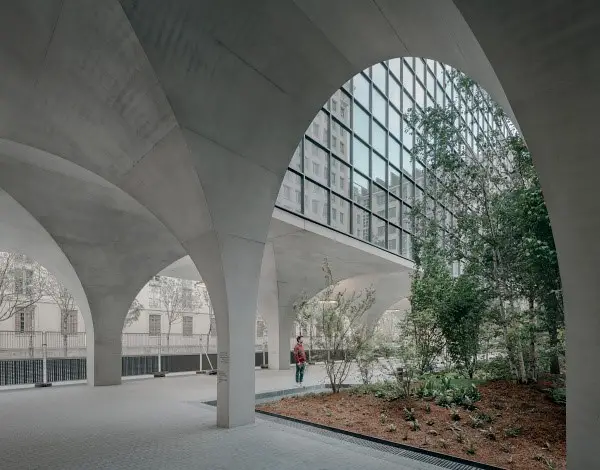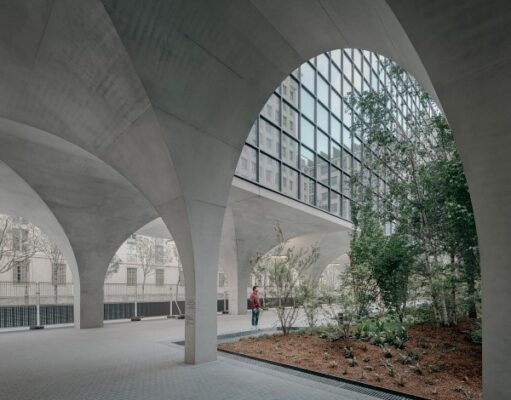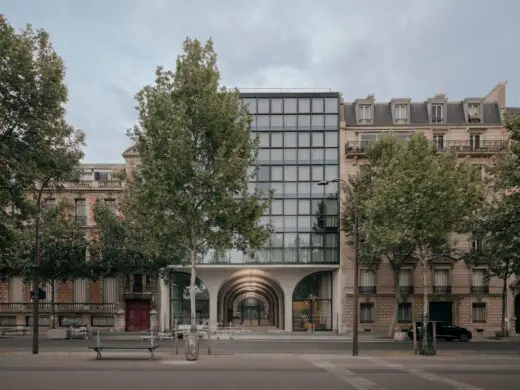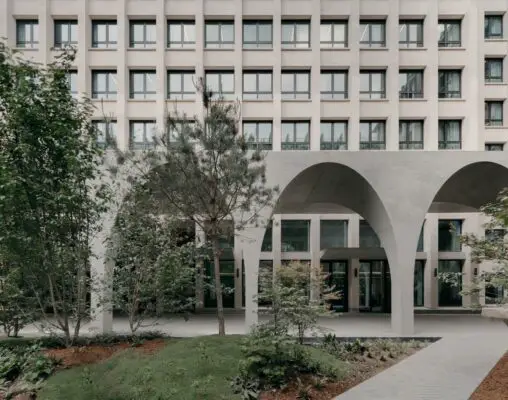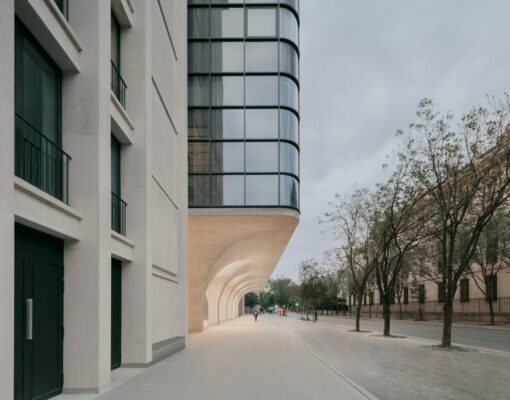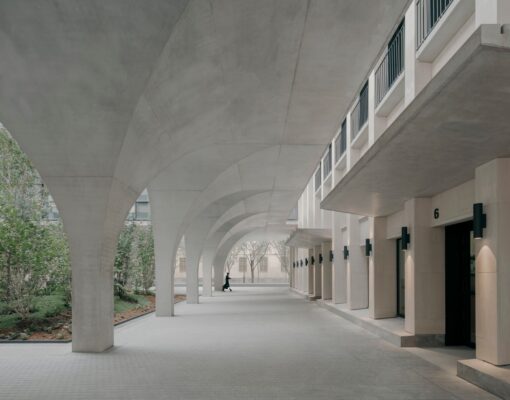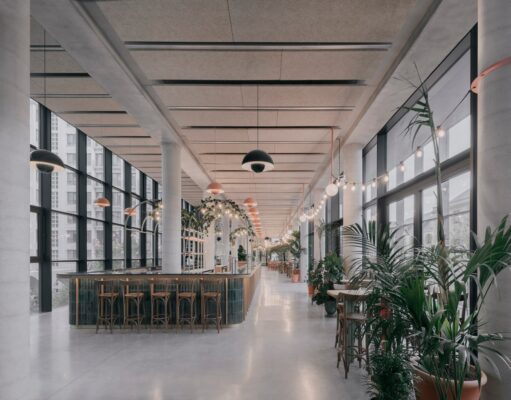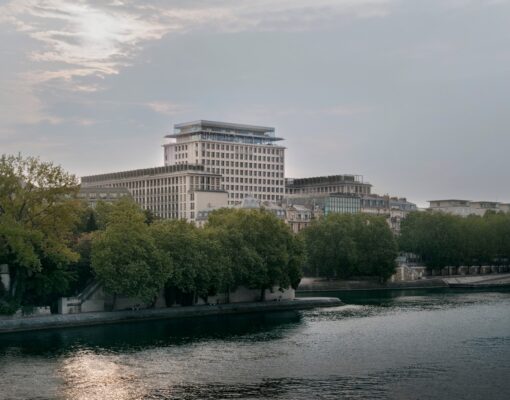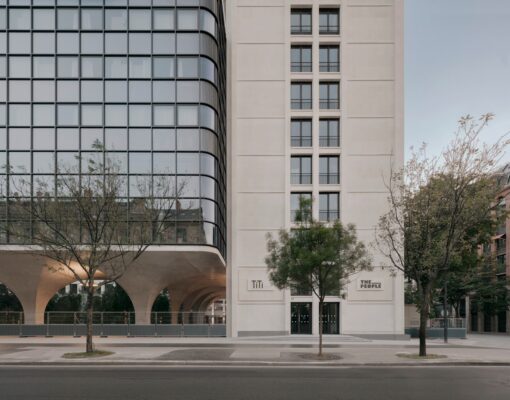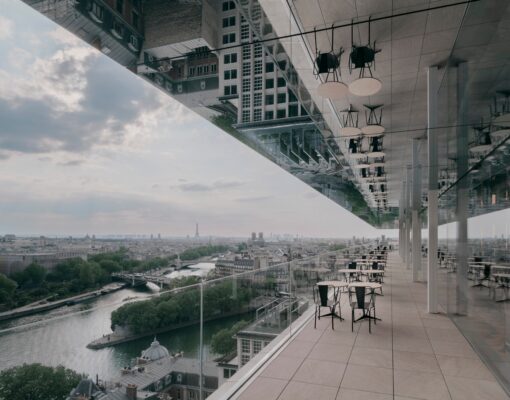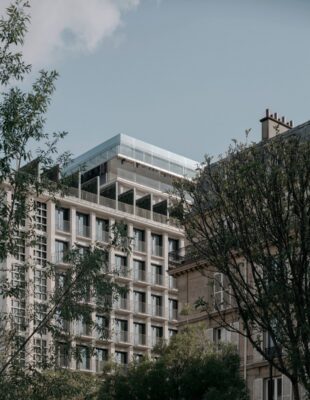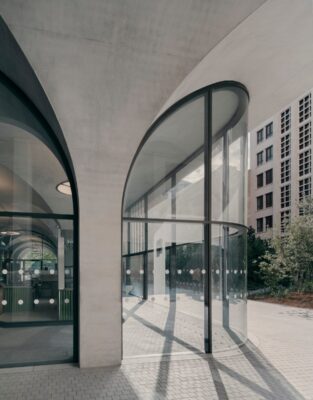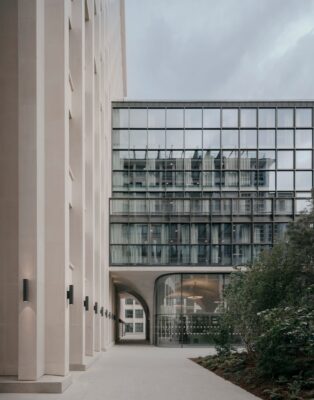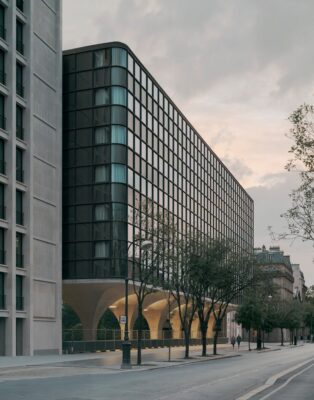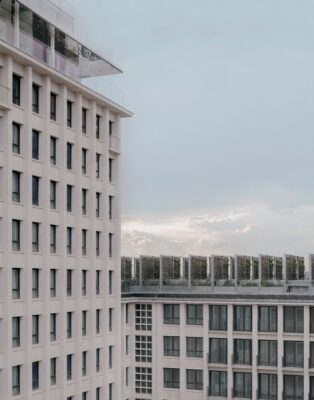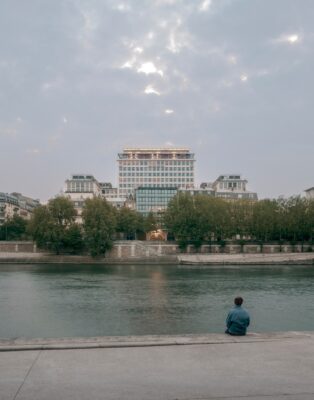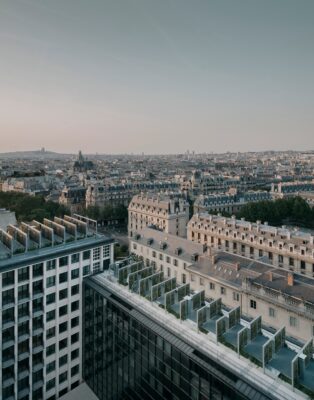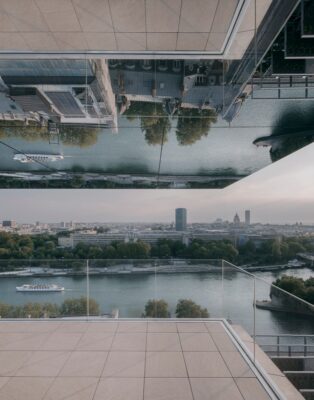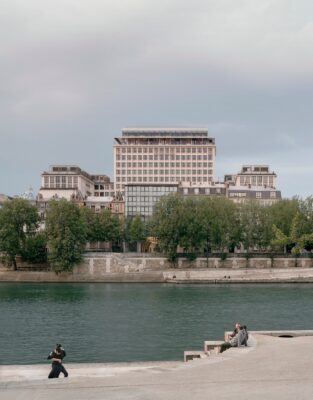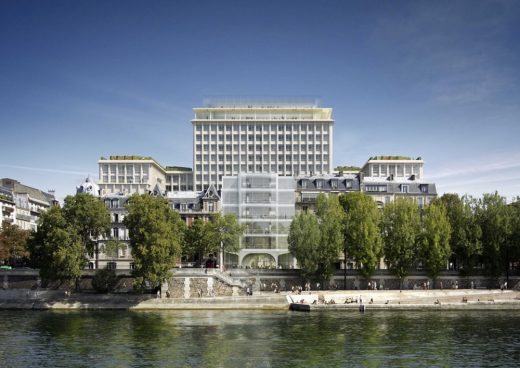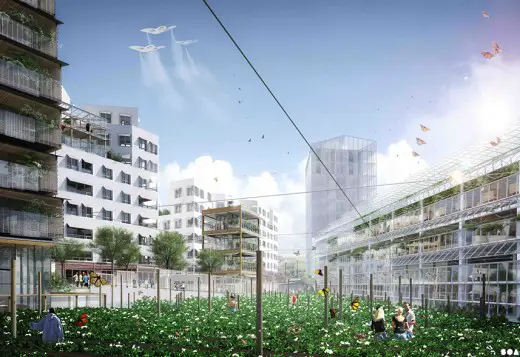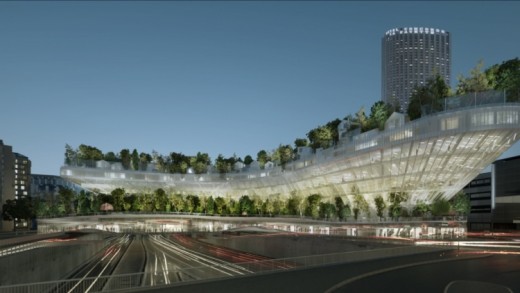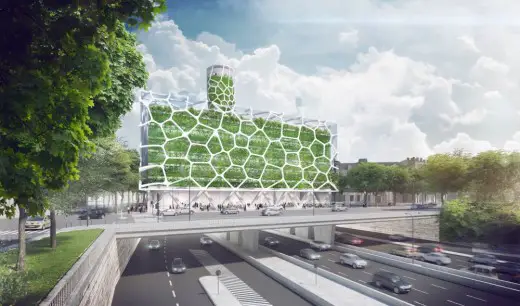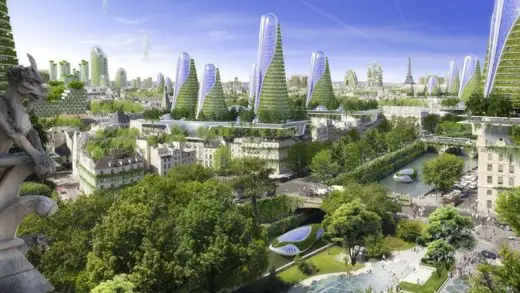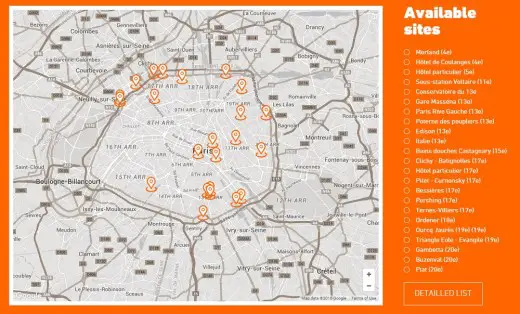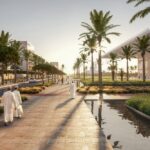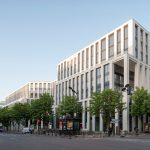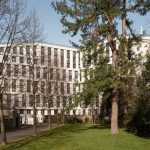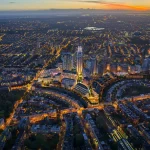Boulevard Morland Mixité Capitale Paris, Reinventer Parisian Building Redevelopment Design, Architect
Morland Mixité Capitale Paris Building News
17 May 2022
Morland Mixité Capitale in Paris completes
Design: David Chipperfield Architects Berlin
Location: 17 boulevard Morland, 4th arrondissement, Paris, France
Photos © Simon Menges
Morland Mixité Capitale Paris
17th of May 2022 – Following six years of design and construction, the mixed-use complex Morland Mixité Capitale in the centre of Paris has been completed. The building on the banks of the River Seine was originally constructed in the 1960s and has been refurbished, remodelled and extended by David Chipperfield Architects Berlin. The official opening will take place on 22 June.
The former ‘Préfecture de Paris’ on Boulevard Morland served the city’s population as an administrative building for decades. In 2016, the team David Chipperfield Architects Berlin and the French developer Emerige won the Call for Projects ‘Reinventer Paris’ for the complex – with their concept to make the previously introverted complex accessible to the public again, transforming it into a lively and open destination with the character of a campus and emanating a positive effect for the overall neighbourhood.
Two new building volumes facing the boulevard and the River Seine, which mediate between the scale of the existing and neighbouring buildings, contribute to the repair of the city. The volumes are raised above the ground to create a new public axis that provides a passage from the boulevard to the River Seine. Load-bearing, vaulted arcades characterize this passage at ground floor level and act as a counterpart to the stringent column grid of the existing ensemble. The complex accommodates a wide spectrum of usages: upscale and affordable housing, a hotel, a youth hostel, offices, retail, a gallery, a food market and a childcare facility. The two top floors house an inhabitable art installation, a bar and restaurant providing wide vistas over the French capital.
Preserving and further developing the existing building not only ensures urban continuity, but also forms an essential component for the comprehensive sustainability concept.
David Chipperfield about the project:
“I believe more than the design excellence of an individual building and its construction, architectural quality today is seen in the ways in which the building connects with its surroundings and enriches quality of life for all citizens, addressing a holistic approach to sustainability. In the case of Morland Mixité Capitale, the gesture towards the public realm and the creation of a semi-public space was an important aspect, as well as the overlapping of different activities.”
Photography © Simon Menges
Morland Mixité Capitale
Paris, France
2015–2022
David Chipperfield Architects
Additional information
1 Historic building and competition ‘Réinventer Paris’
2 Urban and architectural concept
3 Sustainability
4 Landscape architecture and roof gardens
5 Art installation by Studio Other Spaces
6 Facts and data
1 Historic building and competition ‘Réinventer Paris’
Under the motto ‘Réinventer Paris’, the Paris city government launched an international competition in November 2014 directed at developers, investors and architects and planning consultants from all over the world. The French capital aimed to reinvent itself and offer a better quality of life in the city. 23 public spaces and buildings were selected to be redesigned, including the former prefecture in the 4th arrondissement. All projects were to develop exemplary solutions to the pressing questions of sustainable urban design. The resulting innovative, economically and ecologically sustainable ideas for housing, density, mixture and energy aspire to give the metropolis new impetus in the long-term.
The contract for the conversion of the building in the Marais district at 17 Boulevard Morland was awarded in 2016 to the Société Parisienne du Nouvel Arsenal, represented by the investor Emerige, together with a large team of planning consultants and users under the artistic direction of David Chipperfield Architects Berlin, Michel Desvigne Paysagiste and Studio Other Spaces. This team were selected from a shortlist of three further finalists. In order to be able to undertake the revitalisation project, the investor, the French real estate company Emerige, bought the site from the city. After completion, the property was acquired by Nuveen Real Estate.
The prefecture building was originally designed by the architects Albert Laprade, Pierre-Victor Fournier and René Fontaine and built from 1957 to 1964. The site is located on a former river island – Île Louviers – which is roughly the same size as Île de la Cité. In 1843, the Grammont arm that separated the island from the Boulevard Morland was filled in and the site was connected to the right bank of the Seine. The 16-storey building with an H-shaped ground plan is 50 metres tall and is visible from afar.
It is situated in the heart of a district characterised by Baron Haussmann and provides exceptional views over Paris. Along with the UNESCO and NATO buildings, the building was one of the largest of its time in Paris. It comprises a concrete skeleton with stone cladding typical of modernism and is defined by functional geometric architecture. When it opened, the prefecture was a state-of-the-art office building, equipped with an internal telephone exchange and a pneumatic tube network for mail distribution.
2 Urban and architectural concept
For five decades, the complex served the city’s population as an administrative building. Nevertheless, its imposing size, rational architectural expression and limited public accessibility made it seem like a foreign body in the urban fabric of Paris, rather than an organic part of the city.
The strength of cities – and buildings – is revealed in their ability to change, adapt and reinvent themselves according to the changing habits and needs of society. Following a concept of continuity and despite the aesthetic constraints associated with the building’s appearance, its demolition and replacement with a new building was regarded neither justifiable nor desirable. This is particularly the case at a time when the preservation and reuse of buildings, products and materials contributes significantly to a reduction of the carbon footprint.
The building, completed around 1960, was still fit for purpose and in good working order. On closer inspection and after analysing its geometry and proportions, both the classical order of the building and the construction method, an early in-situ concrete construction, appeared to have qualities worth preserving. The same applies to the cladding material of the columns and façades, a cream-coloured natural limestone that can be seen in many Parisian buildings and thus subtly integrates the building into its urban context.
The approach for this project was therefore to transform the overall complex into something new by means of conversion and extension in combination with convincing architectural, programmatic and organisational ideas. The existing building structure formed a robust basis for further development with the aim of making the building complex and the city tangible in a new way, in particular with regard to the panoramic views over Paris.
Very early on in the design process, it became clear that the ground floor and the top two floors of the tower should be made available to the public. Active public use is essential in transforming the former Préfecture into a place of community life once again. Based on this concept, the whole ground floor throughout the entire block from the street Boulevard Morland to Quai Henri IV, is now accessible to all with a public path at ground floor level. The top two floors with the rooftop bar can also be accessed from here.
Two new volumes complete the urban block along Boulevard Morland and Quai Henri IV.
The new building on Boulevard Morland transfers the entrance and address of the large
building complex back to the street, softening the commanding gesture of the tower. The
imposing forecourt is transformed into a well-proportioned inner courtyard and mediates
in scale between the library opposite and the tower. The new building volume on Quai
Henri IV closes the gap to the adjacent turn-of-the-century buildings in terms of urban
repair.
The two new buildings bridge the site between the two existing wings and are
raised above the ground floor by arcades. On the second floor, the arcades connect with
the tower, bringing together all sections of the building. The new arcades made of insitu concrete allow a flexible division of space on the ground floor for both current and future uses. In addition, they give the building complex a completely new identity and an
open character. Both on Boulevard Morland and on Quai Henri IV, their clear tectonic
and sculptural form marks the new connecting route for everyone who visits, lives in or
passes through the building complex.
The mixed-use programme creates a lively campus where people are present at all times of the day: While some live here, others take their children to the childcare facility in the morning or come to the office to work. During the day, visitors use the retail facilities and the quiet courtyards to relax or they meet in the evening in the hotels and restaurants. The swimming pool is not only available to hotel guests, but also to students from the neighbouring schools. By integrating a diverse variety of private and public functions, the project creates a microcosm, a city within the city.
3 Sustainability
The core architectural idea for the project was to preserve, renovate and further develop the existing building. This not only ensures urban continuity, but also represents the most important component for the project’s sustainability concept, which has achieved certification with a range of French and international sustainability standards.
Preserving building fabric as far as possible significantly reduces CO² emissions and saves energy in terms of demolition and disposal. With great respect for the existing building fabric, the renovation of the former Préfecture repaired all elements that were not too damaged with the aim of preserving them. All the stone slabs of the façade were cleaned, repaired and only damaged slabs were replaced. The stone used for this, like the one originally used, comes from the Buffon quarry in Burgundy.
Any alterations or additions to the façade were made for the benefit of living quality and due to legal requirements. For example, all rooms were given additional external areas through the integration of new balconies and storey-high windows. The original steel windows no longer met the current standards for thermal insulation and were therefore replicated as aluminium windows. These changes in appearance fit into the design concept and character of Laprade’s design, developing it carefully further. Inside, modified, flexibly designed floor plans ensure that the complex can be re-used in the long-term – even if there is a conversion of use in the future.
The further development from its original use as an administration building to a lively mixed-use gives the complex a second lease of life by adapting to the demands and desires of a modern city and society. The principle of flexible use is therefore continued also in the new parts of the building. With the arcades on the ground floor, the complex now has a durable, robust primary structure made of in-situ concrete that has been designed so that it can also be used for different purposes in the future. By cleverly bundling the shafts, the areas under the arches can be used as interior space as well as exterior space by adapting them with a flexible final finishing layer with little structural intervention.
The green courtyards and the roofscape serve as water reservoirs in terms of a “sponge city”. They can absorb rainwater, store it and release it when needed. The intensive planting – including urban gardening with vertically planted crops to maximise the cultivation area and minimise water consumption – binds fine particulate matter and encourages biodiversity. A closed phyto-purification system is used for irrigation, in which grey water from the hostel is treated, stored and reused as irrigation water.
The energy cycle, including heating and cooling, is designed according to the same principle: Based on heat exchange, the different uses within the project can benefit from each other. The waste heat generated in the office areas facilitates for instance the hot water supply in the hotel by connecting the systems to three heat pumps via a water circuit. This system reduces the total consumption of the building by 15% below the prescribed regulations. The additional energy required is supplied by collective district heating and cooling systems. In addition, photovoltaic panels on the roofs generate energy that is used for operations.
4 Landscape architecture and roof gardens
Text provided by Michel Desvigne Paysagiste
Situated between the Île Saint-Louis and the Marais neighbourhood, the building presents an unparalleled panorama on the historical centre of the city and well beyond. On the ground floor, three inner courtyards compose a densely planted landscape, surrounded by mineral terraces and traversed by more informal pathways. The landscape is both circumscribed within the interior of the building and positioned as an extension of public space. Due to the reduced amount of sunshine of the built environment, we propose to transpose here a miniature forest made of plant varieties adaptable to the specific circumstances. Trees of varying size, bushes, herbaceous plants, ferns are all chosen in conjunction with one another and made the subject of a work of composition and acclimation.
Partially accessible by residents, numerous terraced roofs benefit from the presence of much sunshine and exceptional orientation. The higher terraced roofs allow for the addition of spatial innovations and new functions: in particular, a system of vertical plant cultivation (2,300 square meter surface of vertical plant cultivation distributed over just 590 square meters of ground, composed of over 150 plant varieties), and the development of organic cultivation methods (bio-filtration of grey waters serving the vertical cultivation areas).
In parallel, by means of their orientation and arrangement, the ornamental gardens create special places for visitors. The intermediate terraced roofs, which will remain inaccessible, will be planted with simple flower-covered green expanses. The integration of the technical facilities into the building will be realized so as to conceal them and lessen their visual impact.
5 Art installation by Studio Other Spaces
Text provided by Studio Other Spaces
‘The seeing city’ is a site-specific, permanent artistic installation designed for the top two floors of the Préfecture de Paris on Boulevard Morland as part of the larger Morland Mixité Capitale Project. The work comprises a mirror ceiling on the 15th floor and a kaleidoscopic ceiling that fades into the sky on the 16th floor. The two levels are transformed into an immersive optical apparatus that transports Parisian street life to the rooftop and its interior spaces, while reflecting the activity in those spaces back down to the city below.
As visitors move through the 15th floor, its mirror ceiling, which extends from the exterior into the interior, appears to dematerialise the space. The Seine the streets of Paris float above them as an inverted city in motion. Visual qualities change with the outdoor light and weather conditions, with the flow of the river and traffic below, and with the visitors’ movements and shifting perspectives as they navigate the space. The reflective ceiling also gives onlookers from the street and surrounding buildings a glimpse of the 15th floor that would otherwise be opaque. In this way, the work blurs the boundary between inside and outside, creating a transition from the interior space of the building into the dynamic city beyond.
On two opposing sides of the 16th floor, rows of kaleidoscope boxes line the glass facades. The Quai Saint-Bernard side faces the Seine, and the Boulevard Morland side looks out onto the cityscape. Each kaleidoscope box is composed of four glass mirror panels. The sides are reflective at the top and transparent at the bottom, featuring a custom faded pattern that creates a seamless transition between the reflective and transparent surfaces. The boxes are topped with clear glass domes and are open at the bottom, drawing the sky above into the interior.
The overall fade effect of the artwork smoothly blends the panoramic view of the city with the kaleidoscopic sky extended by the mirrors. Interior and exterior are fragmented and reconfigured into an assemblage of seemingly infinite permutations. The effect continues on the exterior surface of the glass and is visible from the surrounding streets. Viewed from the city below, the work disappears into the sky when the weather is calm, and stands out in stark contrast when the reflection differs from the surrounding sky, as at sunrise and sunset. Recognisable while harmonising with the existing cityscape, the work creates a delicate beacon atop the building by subtly amplifying the atmosphere and surroundings.
‘The seeing city’ speaks from its immaterial qualities, which are inspired by the desire to optically interpret the existing building rather than replacing the original structure with something entirely new. The intention is to connect people to the everyday context that they inhabit in a way that is surprising and dynamic, whether they are floating above or looking up from the boulevard.
Morland Mixité Capitale Paris – Building Information
6 Facts and data
Client: Société Parisienne du Nouvel Arsenal,
represented by Emerige
Address: 17 boulevard Morland, 75004 Paris, Frankreich
Programme Office: 9,200m²
Housing: 15.400m² (202 apartments), including subsidised
housing: 12.400m² (164 apartments)
Hotel and gastronomy: 10,500m²
Youth hostel: 4,200m²
Pool and fitness: 1,600m²
Kindergarten: 800m²
Food market: 400m²
Art gallery: 290m²
Retail: 1,000m²
Green spaces 4,000m² total, including:
Urban Gardening: 2,800m²
Roof gardens: 300m²
Three green courtyards: 1,000m²
Height: 50m
Site area: 8,400m²
Gross floor area: 63,500m²
Width x length: 88 x 115m
Floors above ground: 16 (tower), 10 (existing wings), 6 (new wings)
below ground: 4
Sustainability certificates
Housing:
Certification NF Habitat HQE
BBC Effinergie Rénovation
Office:
Certifications HQE Rénovation/Neuf 2015 Excellent
BBC Effinergie renovation
BREEAM Very Good
Entire building:
Wiredscore Gold
Morland Mixité Capitale Paris images / information from David Chipperfield Architects Berlin
Previously on e-architec:
6 Feb 2016
Boulevard Morland Paris
Boulevard Morland Paris Development
DCA wins Morland Paris
03.02.2016 – Following a three-phase competitive process, David Chipperfield Architects Berlin, together with Paris-based developer Emerige, has won the Call for Projects to redevelop the ‘Boulevard Morland’ site in the 4th arrondissement of Paris.
Boulevard Morland Paris Building
The process is part of the wider city-led urban regeneration initiative – ‘Reinventer Paris’ – calling for innovative projects to redevelop 23 sites across the city.
David Chipperfield architect and Sou Fujimoto have been named among the high-profile winners of a series of linked design competitions aimed at reinvigorating sites across Paris.
Reinventer Paris Building designs:
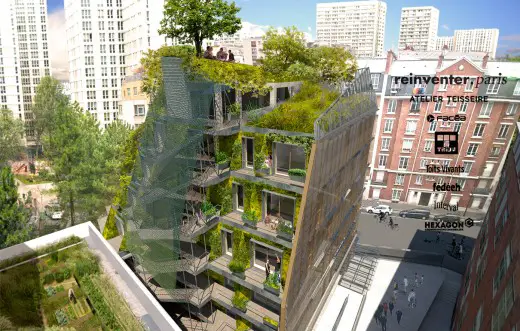
source: http://www.reinventer.paris/en/
Boulevard Morland Reinventer Paris Building design:
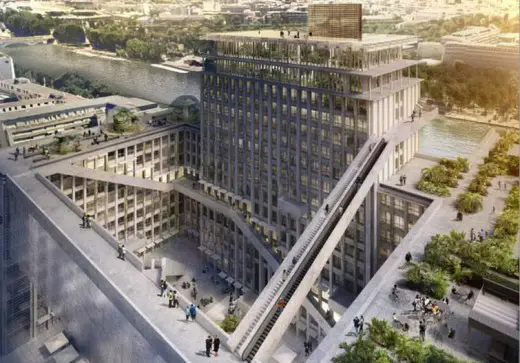
Reinventer Paris Building design by Vincent Callebaut:
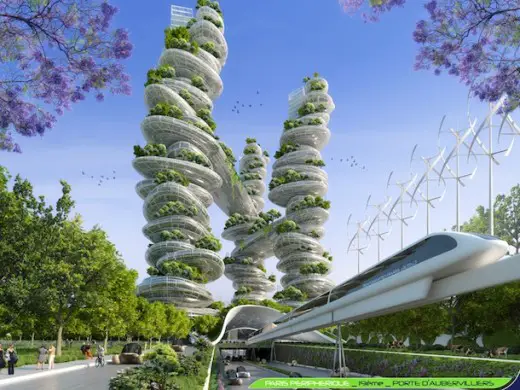
Reinventer Paris Building Designs
David Chipperfield Architects News
Location: Boulevard Morland, Paris, France, western Europe
New Paris Architecture
Contemporary Paris Architecture
Paris Building Designs – chronological list
Paris Architecture Tours by e-architect
Paris Architecture – Selection
Design: Manuelle Gautrand Architecture
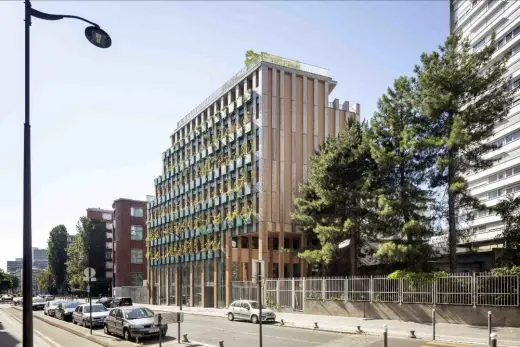
photo © Luc Boegly
Edison Lite Homes Paris
Architects: VenhoevenCS and Ateliers 2/3/4/
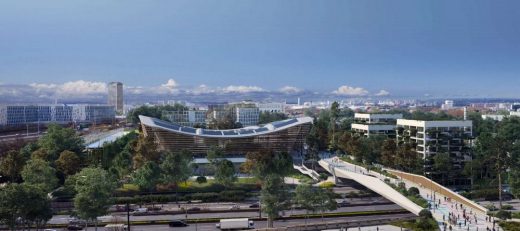
image courtesy of architects
2024 Paris Olympics Aquatics Center Building
Hermitage Plaza
Design: Foster + Partners
Hermitage Plaza
Docks de Paris, Cité de la mode et du design
Design: Jakob+MacFarlane
Cité de la mode et du design
Comments / photos for the Morland Mixité Capitale Paris Building design by David Chipperfield Architects Berlin page welcome

